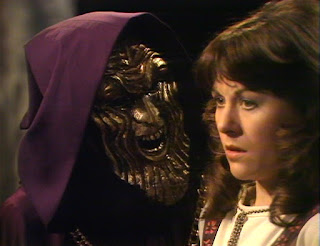The one where a hypnotised Sarah tries to kill the Doctor...
It's amazing just how physical the Doctor has got in the last few stories. It must be influenced by the climate in British television at the time, which was heavy with police procedurals like The Sweeney, and action-packed adventure series imported from America. The Doctor is particularly active in this story, leaping on horses, assaulting guards, and engaging in swordplay with Federico's men. In fact, the Doctor appears to revel in the idea of a good honest fight these days.
Despite bursts of action such as the fight between Giuliano and the Doctor, and Federico's men and the brethren, this story is, for the most part, very talky, and has the look and feel of a Shakespearean serial. I imagine kids back in 1976 found this story a little underwhelming, although you can't knock how fabulous it looks thanks to a solid production team: director Rodney Bennett, designer Barry Newbery, costume designer James Acheson and lighting designer Dennis Channon.
At one stage, Giuliano says that Leonardo Da Vinci will be attending his masque, with his patron the Duke of Milan, which throws a little doubt on the date established for this story in Philip Hinchcliffe's novelisation. The book says it's 1492, when the Duke of Milan was Gian Galeazzo Sforza, but it was actually his nasty uncle (and successor) Ludovico who was Da Vinci's patron. Ludovico didn't become Duke of Milan until 1494 (after allegedly poisoning his young nephew), but it's also true that Da Vinci had other patrons, including the Medici and the Borgias, so it's anyone's guess who's really accompanying Leo to the dance!
Hieronymous manages to drug and hypnotise Sarah into trying to assassinate the Doctor with a poisoned needle, and, as ever, Elisabeth Sladen is utterly convincing when playing possessed. The scene where she creeps silently up behind him, needle aloft, is chilling, until the Doctor spins round and restrains her arm, desperately trying to convince her he's her best friend. It takes very little persuasion for Sarah to see the truth thankfully.
Down in the palace dungeons, Giuliano's companion Marco is being tortured with burning irons by a man called Scarlatti, a "craftsman" in his field it seems. Despite the torture, Marco refuses to betray his Duke, and it's fair to say Tim Piggott-Smith looks suitably exhausted!
One thing I don't buy is how the Doctor suspected Sarah wasn't herself. He says it's because she asked how she could understand Giuliano's Latin, stating that she'd never bothered to ask this question before. "It's a Time Lord's gift I allow you to share," he explains, but why would Sarah - an inherently inquisitive person - asking a perfectly reasonable question arouse such suspicion? It would have been much better to have Sarah slip up by saying something she couldn't possibly be aware of, or asking about something she already knew, thus arousing suspicion. Her simply asking a perfectly reasonable question doesn't hold water for me.
As the episode draws to an end, the Mandragora Helix is busy empowering the brethren with unspecified powers, and taking to the streets of San Martino in a bid to wrest control from either Giuliano or Federico. It reminds me of the revolt by the Sons of the Harpy and the rise of the Faith Militant in Game of Thrones, except we don't see anything quite as exciting in The Masque of Mandragora!
The cliffhanger is great, as Federico is cast to the ground by a bolt of energy from Hieronymous's finger, and the astrologer reveals that his entire being has been eaten away to leave just a simple glow of energy within the cowl. Chilling stuff!
First broadcast: September 18th, 1976
Steve's Scoreboard
The Good: That very last image of the blank-faced Hieronymous stays with you.
The Bad: The idea that the Doctor knows Sarah has been hypnotised by the fact she asks him about the "Time Lord gift".
Overall score for episode: ★★★★★☆☆☆☆☆
"Would you like a jelly baby?" tally: 05
NEXT TIME: Part Four...
My reviews of this story's other episodes: Part One; Part Two; Part Four
Find out birth/death dates, career information, and facts and trivia about this story's cast and crew at the Doctor Who Cast & Crew site: http://doctorwhocastandcrew.blogspot.com/2014/07/the-masque-of-mandragora.html
The Masque of Mandragora is available on BBC DVD. Find it on Amazon - https://www.amazon.co.uk/Doctor-Who-Masque-Mandragora-DVD/dp/B002SZQCB6







No comments:
Post a Comment
Have you seen this episode? Let me know what you think!